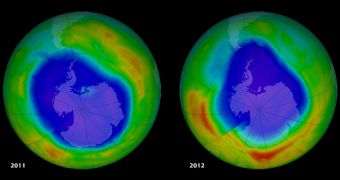The fact that a large hole exists in the ozone layer above Antarctica should not be a shock to anyone. Its existence was determined years ago, and sparked the signing of the Montreal Protocol banning the use of ozone-depleting chemicals in 1986. Now, researchers are looking into how the hole varies in size from year to year.
Anne Douglass, Natalya Kramarova, and Susan Strahan, all scientists at NASA, are now planning to use data sent back to Earth by the space agency's Aura and Suomi NPP satellites to figure out whether or not these yearly variations can be construed as signs that the ozone layer is recovering.
The Suomi NPP satellite, a collaborative effort between NASA and the US National Oceanic and Atmospheric Administration (NOAA), should provide critical information for this research effort.
The group has already decided to focus its study on analyzing differences that occurred in the ozone layer above Antarctica in 2011 and 2012. For these two years, ozone values recorded by satellites varied wildly, with 2011 exhibiting one of the ten largest holes since the 1980s, and 2012 producing the second-smallest ever recorded.
The image linked to this article shows a typical dataset used by researchers to gage ozone health over the course of a year. The photo shows the geographical extent of ozone depletion, as well as the amount of loss that has occurred. These data are collected by the Ozone Monitoring Instrument (OMI) on Aura.
But Douglas says that such images tell researchers nothing about the underlying chemistry and atmospheric dynamics of the ozone layer hole. This is where the Suomi NPP satellite comes in.
Early results of the study reveal that the hole which formed over Antarctica in 2011 would have been equally-large even without the presence of ozone-depleting chemicals, Strahan explains. The amounts of chlorine in the air were much smaller in 2011 than the average, but a large hole developed anyway.
This was due to the fact that winds blew less stratospheric ozone from the tropics to Antarctica. This type of variation cannot be detected by Aura, but NASA has the entire A-Train of spacecraft for conducting such complex atmospheric investigation.
An interesting thing to note is that the yearly extent of the Antarctic ozone layer hole is currently controlled exclusively by weather patterns, since the Montreal Protocol banned the use of ozone-depleting chlorofluorocarbons.

 14 DAY TRIAL //
14 DAY TRIAL //